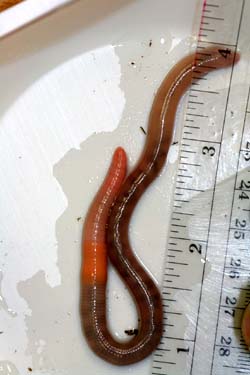
This Giant Palouse Earthworm was found on Paradise Ridge near Moscow, Idaho, on March 20, 2010. Photo by Karl Umiker of the University of Idaho. Courtesy of HistoryLink.org.
Soon after Washington State College opened at Pullman in 1892, the Washington State Agricultural Experiment Station kicked into gear under its auspices. Rennie Wilson Doane was appointed Assistant Zoologist. He began research on pests that were killing local sugar beets, gathering enough data that by 1900 he was able to publish a report identifying a new species of root lice, Pemphigus betae Doane, and he researched the use of large Atlantic oysters in the waters of Willapa Bay. His marriage in 1898 to Miss Elnora Cooper at McMinnville, Oregon, was front page news in the Pullman Herald.
Doane’s work kept him moving. As he followed country roads to farms and fields around Pullman, he began to notice what looked like the burrows of gigantic worms, sometimes fifteen to twenty feet down from the surface of hills sliced open by road cuts. Intrigued, he dug up several specimens of a huge earthworm, pickled them in alcohol and sent them to the nation’s leading earthworm expert, Frank Smith, a zoologist teaching at the University of Illinois. He assured Smith that the worms were abundant in the area.
While Smith admitted that Doane’s specimens seemed incomplete, he believed there was enough physical evidence to conclude that the giant earthworms represented a previously undiscovered creature, a giant earthworm. In a paper published in March of 1897 in The American Naturalist, Smith announced the discovery of the worm he named Megascolides americanus. The name was meant to establish a somewhat sketchy connection between the Giant Palouse Earthworm and some truly immense worms from Australia. Continue reading

